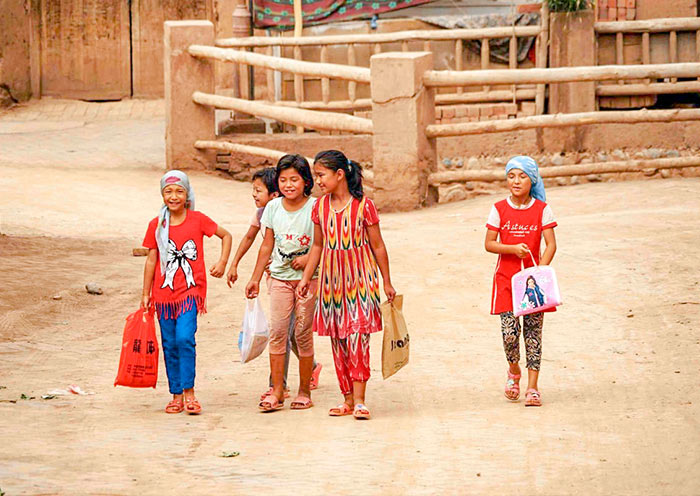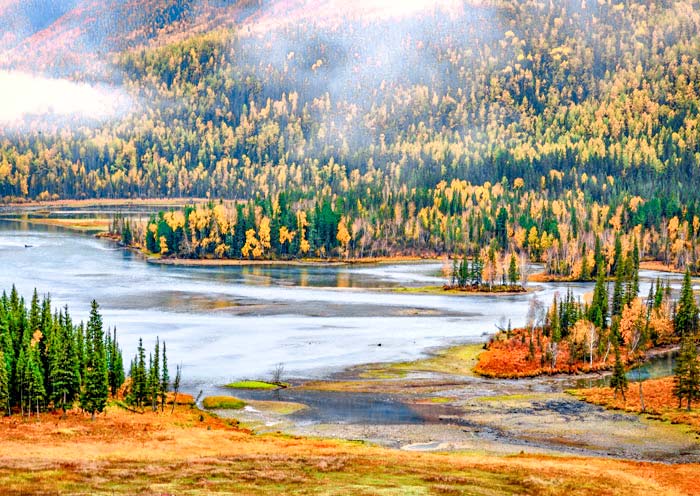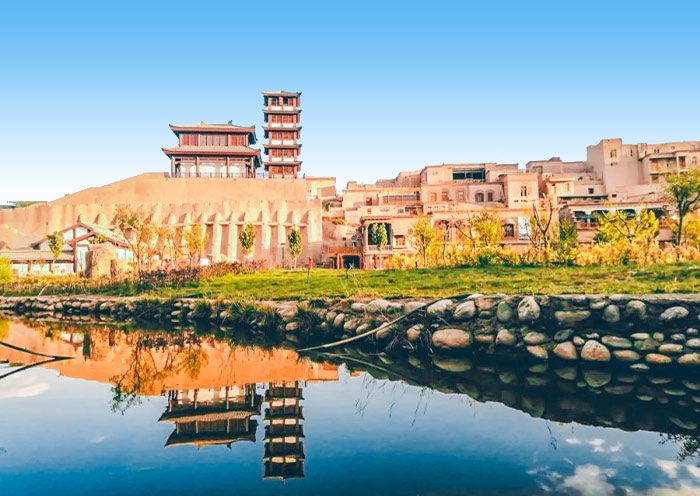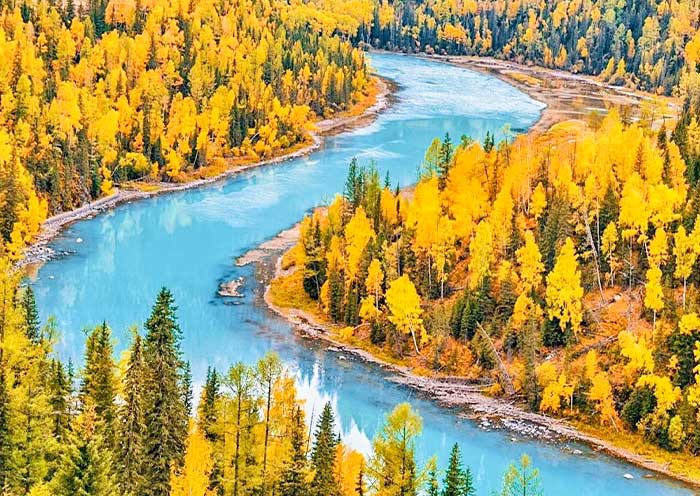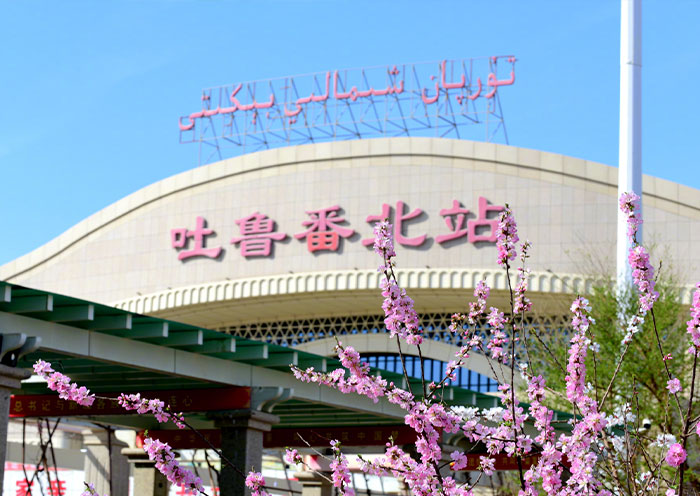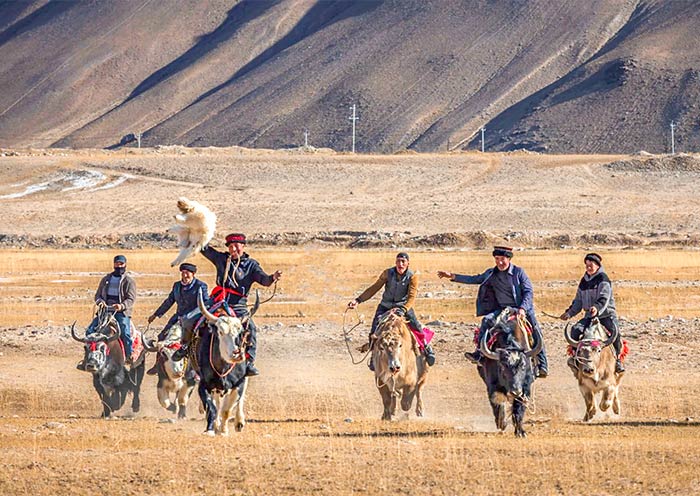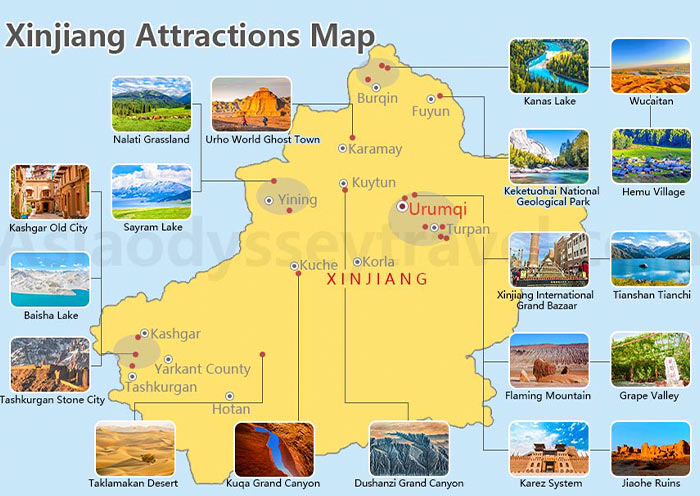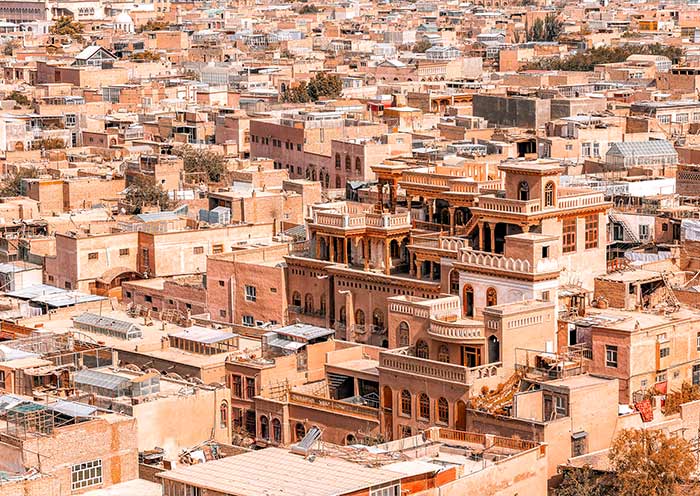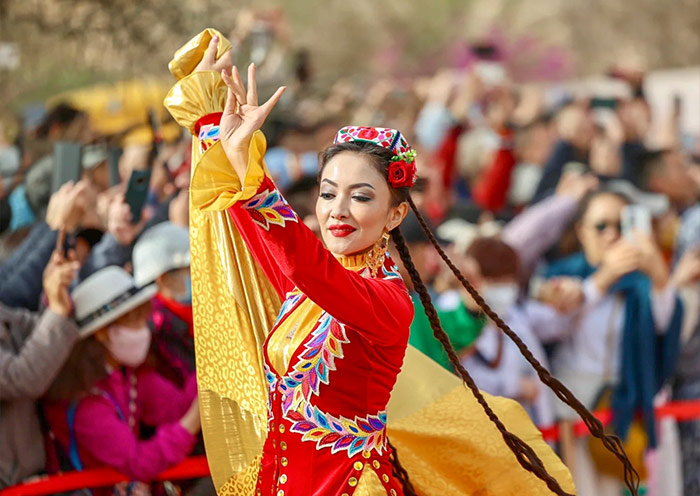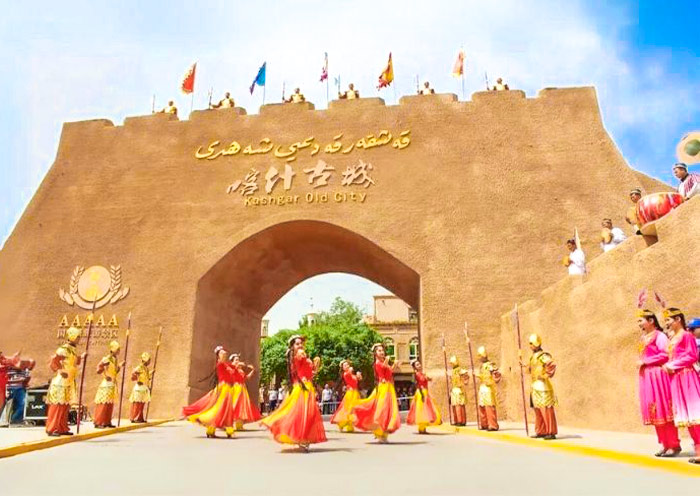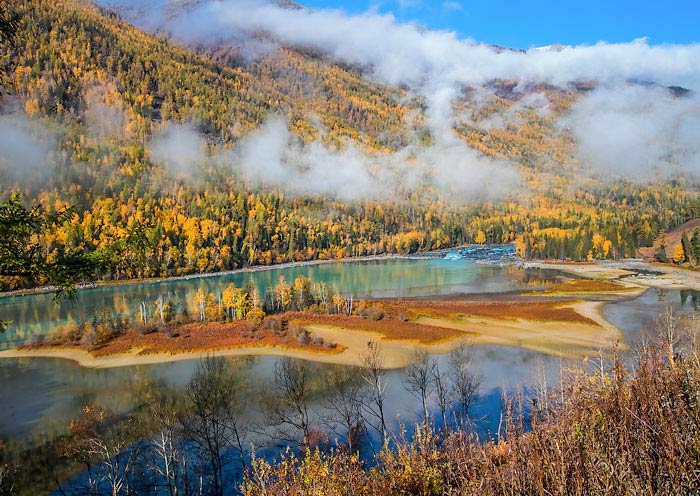Turpan Attractions Map
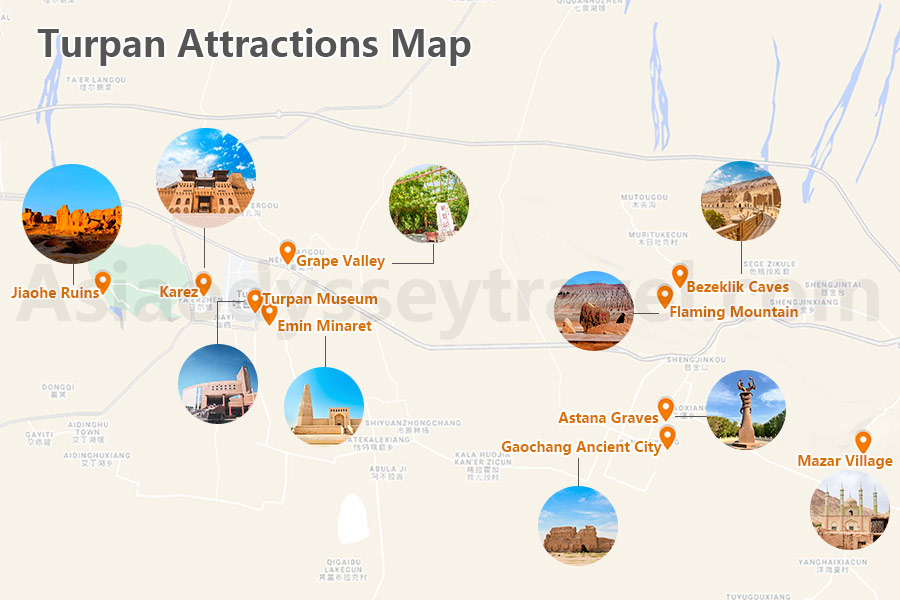
1.Jiaohe Ruins - World’s Best-Preserved Earthen City Ruins
Jiaohe Ruins, or Jiaohe Ancient City, stands on a 30-meter-high, 1700-meter-long, and 300-meter-wide loess plateau in the outskirts of Turpan, with cliffs on three sides, exhibiting a grand and imposing presence. Jiaohe Ancient City is the world's largest, oldest, and most well-preserved city built of rammed earth. As an UNESCO World Heritage Site, Jiaohe Ancient City is one of the most worthwhile attractions to visit in Turpan.


This ancient city, without city walls, was established over 2000 years ago and served as the capital of the Cheshi Kingdom. During the Han and Tang dynasties, it was one of the most prosperous cities on the Silk Road. Eventually abandoned over 600 years ago, it still retains a clear urban appearance despite enduring centuries of wind and sand.
What to See in Jiaohe Ruins
- City Layout: Explore the well-preserved layout of the ancient city, which includes streets, residential areas, temples, and government buildings.
- Residential Quarters: Wander through the ancient residential quarters to get a sense of how people lived in this city centuries ago. You can see the layout of the houses, courtyards, and communal spaces.
- Government Buildings: Visit the remains of government buildings, which were likely used for administrative purposes. These structures offer insights into the governance of the ancient city.
- Temples and Religious Sites: Discover the ancient temples and religious sites within the ruins. These places of worship provide a glimpse into the spiritual practices of the inhabitants.
- Water Management System: Marvel at the advanced water management system of the Jiaohe Ruins, which included wells, cisterns, and underground channels to ensure a stable water supply for the residents.
- Panoramic Views: Take in the panoramic views of the surrounding landscape from elevated points within the ruins. The views of the Turpan Basin and the surrounding desert are particularly striking.
- Sunset Views: If possible, stay until sunset to witness the ruins bathed in the warm glow of the setting sun. The changing light can enhance the beauty and atmosphere of the ancient site.
By exploring these key attractions at the Jiaohe Ruins, you can gain a deeper appreciation for the history, architecture, and culture of this ancient city perched on a plateau overlooking the Turpan Basin.
2.Karez System - Most Representative Irrigation System in Xinjiang
The Karez System, also known as the Qanat System, has a history dating back over 2,000 years in Xinjiang, making it one of the oldest and most extensive irrigation systems in the world. As one of the three greatest engineering projects in China, this ancient technology efficiently transports water from the melting snow of the Tianshan Mountains to the arid Turpan Basin, providing a reliable water supply for agriculture and daily use.
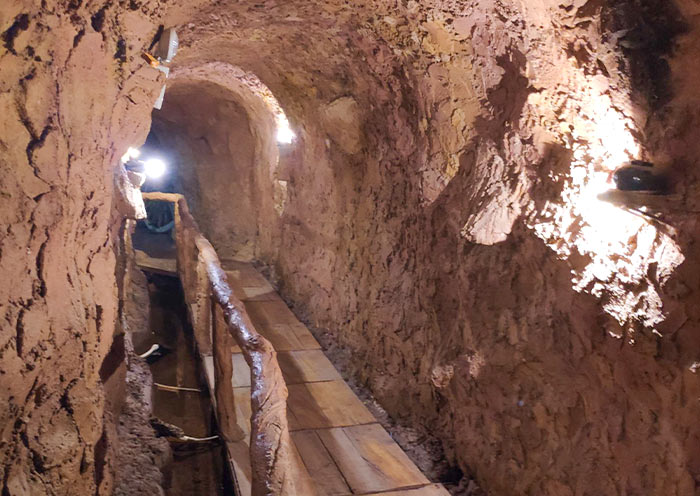

How Karez System Works
The Karez System consists of a series of underground tunnels that channel water from high elevations to lower-lying areas. Along the length of the tunnels, vertical shafts called "qanats" are dug to allow access to the underground water channels. These shafts also serve as ventilation points for the tunnels. The water brought by the Karez System is distributed through a network of smaller canals, channels, and ditches to irrigate crops such as grapes, melons, and other fruits in the region.
The Karez System is known for its efficiency in water conservation, as the underground tunnels help to reduce evaporation losses compared to surface canals. The system also helps to cool the water, making it more suitable for irrigation in the hot desert climate.


3 Spots to Learn Karez System in Turpan
- Jiaoheyi Karez Source Scenic Area (交河驿坎儿井源): This is the source of the Karez System in Turpan. Visitors can take an elevator down several tens of meters underground to observe the clear channels, hidden channels, vertical wells, and other facilities within the Karez System up close.
- Karez Amusement Park (坎儿井乐园): An artificially constructed sightseeing spot based on the Karez System. The park features a large grapevine on the ground, allowing visitors to witness the irrigation process of orchards on the surface by the Karez System.
- Karez Folk Custom Garden (坎儿井民俗园): This is the major attraction introducing the Karez System. The garden includes a museum that showcases the history, excavation methods, operational principles, and more related to the Karez System.
The Karez System is a significant part of Turpan's cultural heritage and a testament to the ingenuity and resilience of its ancient inhabitants.
3.Bezeklik Caves - Intricate Murals & Profound Buddhist Culture
The Bezeklik Caves, also known as the Thousand Buddha Caves, are a significant cultural and historical site located near Turpan in Xinjiang, China. The Bezeklik Caves comprised 83 caves originally, only 57 remain today, with over 40 containing murals, totaling an area of 1200 square meters, making it the largest group of caves with the richest content of murals among the surviving caves in Turpan.

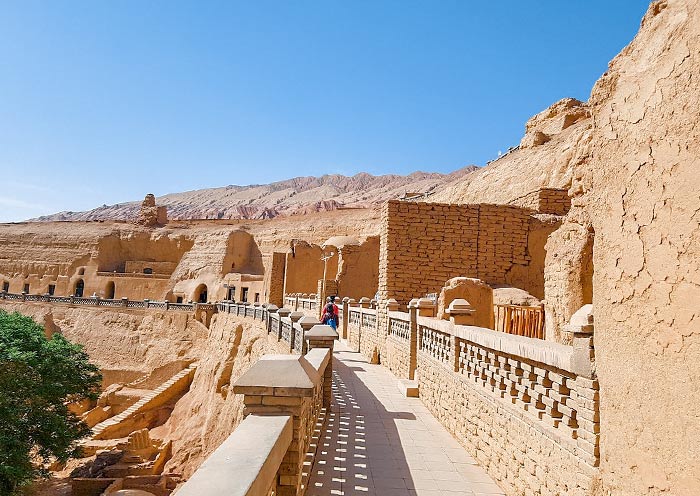
Bezeklik Caves History
The Bezeklik Caves were initially carved out during the Northern and Southern Dynasties (420 - 589 AD). The caves reached their peak during the Tang Dynasty (618-907 AD) and continued to flourish over seven centuries. During this period, the Bezeklik Caves served as a prominent Buddhist center and royal temple of the Gaochang Kingdom in the region.
By the late 13th century, the Gaochang Kingdom had moved east to Yongchang in Gansu. Coupled with the spread of Islam into Turpan, Buddhism gradually declined, and the Bezeklik Thousand Buddha Caves subsequently fell into decay. They suffered damage during religious conflicts, with the eyes of figures in the mural paintings being intentionally defaced.
More unfortunately, in the late 19th and early 20th centuries, explorers from countries such as Russia, Germany, England, and Japan visited Turpan under the guise of archaeology, taking a significant number of murals and artifacts, leaving the Bezeklik Caves in a devastated state.
Currently, most of the original mural fragments are housed in institutions such as the Museum of Indian Art in Berlin, the State Hermitage Museum in St. Petersburg, the Tokyo National Museum in Japan, the British Museum in the United Kingdom, the National Museum in India, and the National Museum of Korea.
Famous Caves to Visit in Thousand Buddha Caves
- Cave 16: Carved during the mid-Tang Dynasty (780-850 AD), featuring murals depicting "Musical Entertainment".
- Caves 17 and 18: The oldest caves, carved in the late period of the Northern and Southern Dynasties (420-589 AD). Cave 17 showcases "Transformation of Hell," while Cave 18 features "Great Lotus."
- Cave 20: Its murals depict the Uyghur Gaochang king and queen. Unfortunately, the original murals are displayed in the Berlin Museum, with colored photographs inside the cave being reproductions of the originals.
- Cave 38: The theme of the murals is "Manichaeism," a religion founded by the Persian Mani.
- Caves 82 and 83: Built during the 10th to 11th centuries, these caves were dedicated small memorial caves specifically for eminent monks of the Buddhist temple.
4.Mazar Village in Tuyugou Valley - Oldest Uyghur Village
Mazar Village, located in the Tuyugou Valley near Turpan, Xinjiang, China, is a historic Uyghur village known for its well-preserved Uyghur architecture, mud-brick houses, narrow alleys, and traditional way of life. The village offers a glimpse into traditional Uyghur culture, architecture, and way of life.
In Arabic, "mazar" means a holy place, while in Uyghur, it signifies the tomb of a saint. Mazar Village is actually a village where tomb guardians reside.
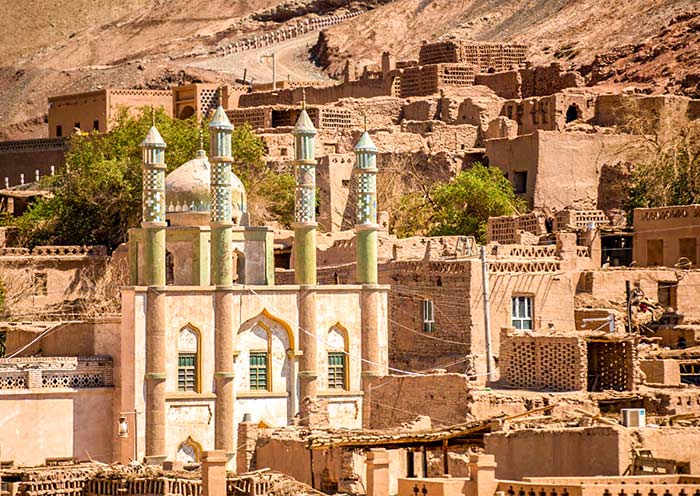
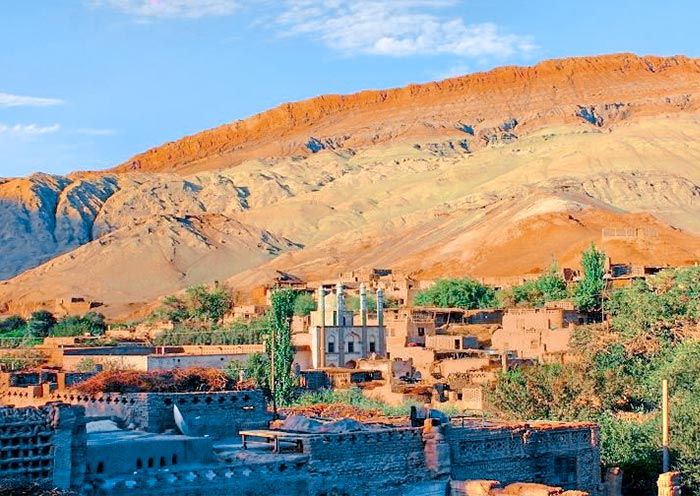
Things to Do in Mazar Village
Admire Architecture: The traditional Uyghur houses in Mazar Village are typically constructed from mud bricks, with intricately carved wooden doors and windows. The architecture reflects Uyghur design aesthetics and the practical considerations of desert living.
Explore Mosque: Visit the village mosque, which serves as a central gathering place for the community and is an important symbol of religious and cultural identity for the Uyghur residents.
Purchase Local Crafts: The village is known for its handicrafts, including pottery, weaving, and woodcarving. Visitors have the opportunity to purchase handmade souvenirs and interact with local artisans.
Try Local Cuisine: Explore the unique flavors of Uyghur cuisine in Mazar Village. Sample dishes such as laghman (hand-pulled noodles), kebabs, samsa (meat pastries), and the famous Xinjiang-style pilaf.
5.Emin Minaret - Largest Islamic Minaret in Xinjiang
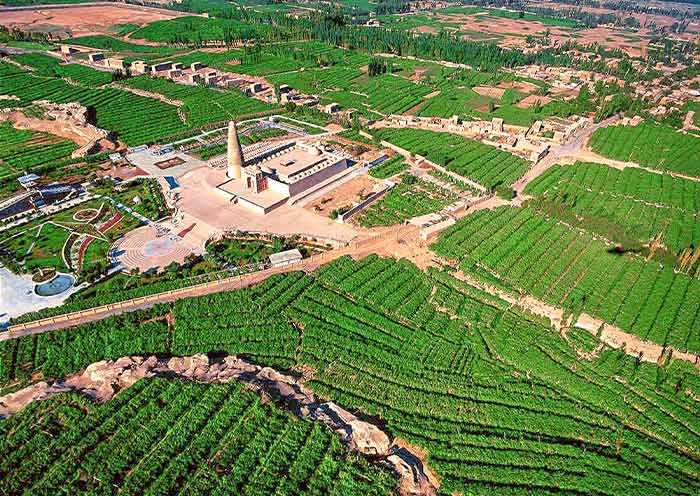
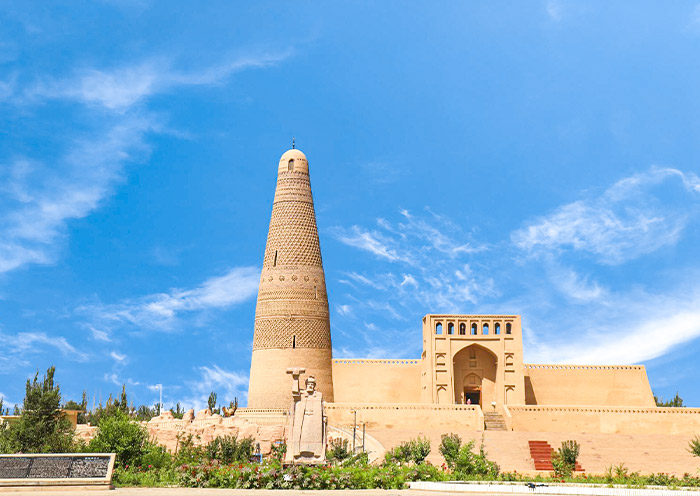
The Emin Minaret, also known as Sugong Pagoda, is a towering Islamic minaret and historic landmark located in central Turpan, Xinjiang, China. Standing at over 44 meters tall, the Emin Minaret is one of the tallest Islamic minarets in China, offering panoramic views of the surrounding Tuyugou Valley and the Flaming Mountains.
The minaret is named after the Turpan ruler Emin Khoja, who was the first generation of Turpan in the Qing Dynasty. It was finished in 1778 by Emin Khoja’s son, to commemorate and honor his father for his achievements.
What to See in Emin Minaret
Unique Tower Architecture: The conical tower has a 10-meter base diameter and tapers as it ascends. Inside, a spiral column leads to the top, though climbing is prohibited for tourists. Adorning the exterior are 15 intricate Uyghur geometric patterns, like rhombuses, mountains, water ripples, and four-petal designs, adding cultural richness to the structure.
Islamic Mosque (礼拜寺): Next to the Sugong Pagoda sits a 2500-square-meter mud-built Islamic mosque, the largest in Xinjiang, accommodating over a thousand worshippers. Unlike lavishly decorated Buddhist temples, this mosque features a simple, unadorned interior, emphasizing a stark and austere ambiance.
County Prince's Mansion (郡王府): Right next to the Sugong Pagoda is the County Prince's Mansion, which has been restored to its appearance during the reign of Emin Hoja. It features various structures such as a council hall, a reception hall, the main residence, a mosque, barracks, and stables.
6.Flaming Mountain - Intense Heat & Red Rocks
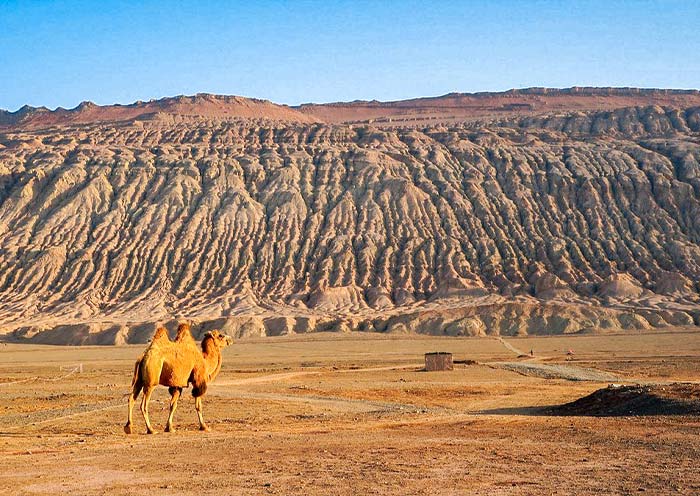

The Flaming Mountain, located near Turpan in Xinjiang, China, is a famous natural landmark known for its stunning red sandstone cliffs, extreme summer heat, and its mention in the classic Chinese novel "Journey to the West."
Highlights of Flaming Mountain
Unique Geographical Features: The Flaming Mountain is a barren, red sandstone mountain range that stretches for about 100 kilometers (62 miles) along the northern edge of the Turpan Basin. The mountain derives its name from the intense heat and the red hue of the rocks, which give the illusion of flames in the sunlight.
Hot Climate & High Temperature: The Flaming Mountain is notorious for its scorching temperatures, especially during the summer months when the surface temperatures can soar to over 50 degrees Celsius (122 degrees Fahrenheit). The harsh climate and rugged terrain make the mountain a challenging environment to traverse.
Cultural Significance: The Flaming Mountain is a prominent cultural symbol in Chinese literature and folklore. It is famously mentioned in the classic novel "Journey to the West" as the fiery obstacle that the Monkey King, Sun Wukong, had to overcome on his journey to the west.
The best time to visit Flaming Mountain is during the spring and autumn months (April-May and September-October) when the weather is pleasant and the crowds are smaller. Avoid visiting during the summer months (June-August) as the temperatures can be extremely hot.
7.Gaochang Ancient City - Largest Ruins in Xinjiang
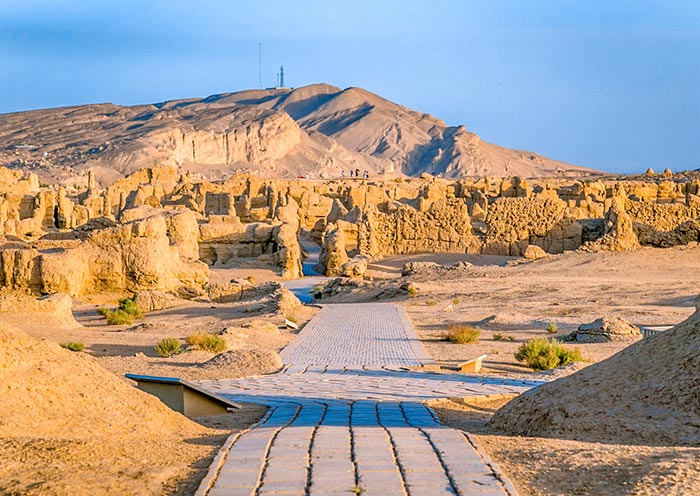
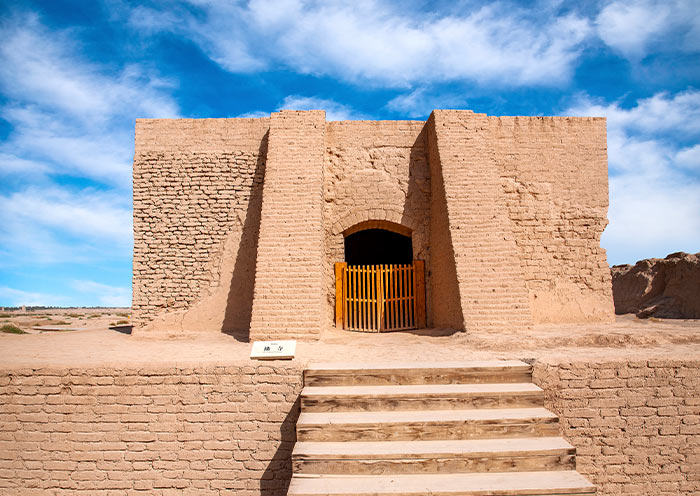
The ancient city of Gaochang, covering an area of about 2 million square meters, was the capital of the Gaochang Uighur period. It is located on the eastern outskirts of Turpan, approximately 40 kilometers from the city center. Gaochang Ruins is the largest ancient city site in Xinjiang, showcasing the remnants of an ancient oasis city that flourished along the Silk Road. In 2014, as part of the Silk Roads: the Routes Network of Chang'an-Tianshan Corridor, it was inscribed on the UNESCO World Heritage List.
History
- Gaochang was first built in the 1st century BC as a garrison of the Western Han Dynasty.
- In the 5th century AD, Gaochang established its local political power, and the city became the capital.
- In the 7th century AD, Gaochang was incorporated into the territory of the Tang Dynasty and renamed Xizhou, with Gaochang serving as the prefectural capital of Xizhou.
- In the 9th century AD, the Gaochang Uighur Kingdom was established, with Gaochang as its capital.
- In the 13th century AD, Gaochang was breached by rebel forces, set on fire, and has since been abandoned, becoming ruins and remnants.
Layout
Similar to the layout of the city of Jiaohe, Gaochang was modeled after the Tang Dynasty capital Chang'an. It has a rectangular plan with a perimeter of 5.4 kilometers and a total area of about 2 million square meters. The city is divided into three parts: the outer city, inner city, and palace city. The inner city is located in the center, the palace city in the north, and the temple district in the southwest and southeast.
The city's layout features well-planned streets, courtyards, and buildings constructed from mud bricks, reflecting the urban planning and architectural styles of the time. Visitors can explore the ruins and imagine life in this ancient city.
8.Turpan Museum - Best Place to Learn Turpan History
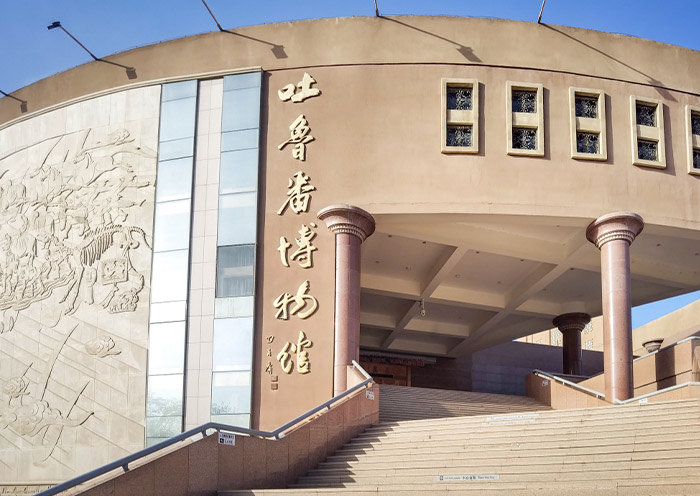
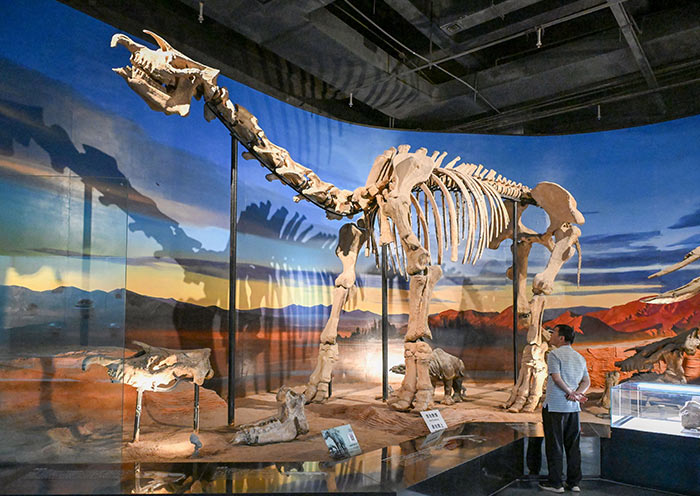
The Turpan Museum, located in central Turpan, is Xinjiang’s second-biggest museum that showcases the rich history, diverse cultures, and archaeological treasures of the Turpan region. The museum houses a diverse collection of artifacts, archaeological finds, cultural relics, and artwork spanning various periods of history, including the Silk Road era, the Gaochang Kingdom, and the Uyghur Empire.
General History Exhibition Hall, Fossils of Giant Rhinoceros Exhibition Hall, and Mummy Exhibition Hall are the most famous halls in the Turpan Museum.
Must-See Collections in Turpan Museum
- Giant Rhinoceros Fossil (巨犀化石): Discovered in Turpan in 1993, this is the most complete giant rhinoceros fossil found in China. The fossil is approximately 9 meters long, 5 meters tall, and the skeleton is intact. The giant rhinoceros lived around 24 million years ago during the Oligocene period and was the largest herbivorous mammal to have ever existed on land.
- Fuxi and Nuwa Silk Painting (伏羲女娲图绢画): Unearthed in 1898 from the Astana Ancient Tombs in Turpan, this silk painting depicts the legendary ancestral deities of China, Fuxi and Nuwa, using white, red, yellow, and black colors. Both deities have human heads and snake bodies, embracing in the upper body and entwined in the lower body, holding symbolic tools representing order and rules.
- Tomb Guardian Beast (镇墓兽): The guardian beast, a mythical creature, was crafted as a funerary object to protect the soul of the deceased from disturbance by evil spirits. Placed in tombs to ward off malevolent entities, these creatures were not real animals but rather imagined divine beings. Unearthed from the Astana Tombs, this guardian beast stands 70 centimeters tall with a tiger head, leopard body, and fox tail. Adorned with brown and blue circular patterns on its bluish-gray body, its fierce appearance is accentuated by its large eyes, protruding teeth, and winged shoulders.
- Mummies (干尸): The hall displays 11 mummies primarily excavated from the Astana Ancient Tombs, spanning from the Spring and Autumn Period to the Qing Dynasty. These mummies include infant mummies, double burials, and the mysterious mummy of a Shaman. Among them is a well-preserved male mummy dating back over 3000 years, showcasing clear hair, teeth, and even visible skin patterns. The complete funerary environment, accompanying garments, and burial items reconstructed by the Turpan Museum present the most primitive and authentic settings, earning it the reputation of being the most horrifying museum.
9.Grape Valley
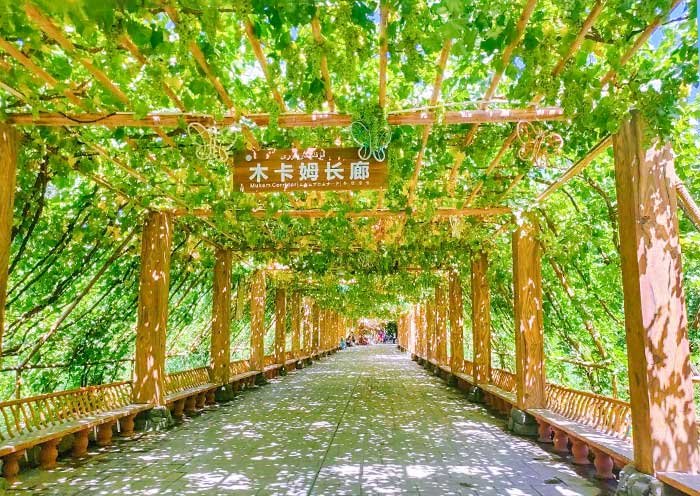

Grape Valley, or Putaogou in Chinese, located in Turpan downtown, Xinjiang, China, is a verdant oasis known for its lush vineyards, sweet grapes, and pleasant climate amidst the arid landscape of the Turpan Basin. Grape Valley has a long history of viticulture dating back 3,000 years ago. The valley's picturesque landscapes, with rows of grapevines stretching across the slopes of the valley, offer a tranquil setting for visitors to stroll, relax, and appreciate the natural beauty of the surroundings.
Things to Do & Attractions in Grape Valley
- Grape Valley Paradise (葡萄沟乐园): This is a 2-kilometer-long grape valley corridor with a stream, waterfalls, and more along the way. You can enjoy the coolness under the grape pergolas.
- Wang Luobin Music Art Museum (王洛宾音乐艺术馆): Established in memory of the famous Chinese folk musician Wang Luobin (1913-1996). Wang Luobin composed many popular folk songs in mainland China, and he lived in Turpan in his later years.
- Dawazi (达瓦孜): Dawazi, meaning "high-altitude tightrope walking" in Uighur, is a traditional acrobatic performance art form passed down for centuries by the Uighur ethnic group. You can enjoy the Dawazi performance for free.
- Afanti (阿凡提风情园): Offers accommodation and dining options with a strong Uighur ethnic flavor. You can also experience grape picking here.
- Frog Alley (青蛙巷): Known for being featured in a famous Chinese entertainment program, Frog Alley is now a unique commercial street where you can purchase local specialties, and handicrafts, and taste delicious snacks.
10.Astana Graves


The Astana Graves, located about 40 kilometers southeast of Turpan, adjacent to the Gaochang Ruins, served as the public cemetery for officials and civilians of Gaochang City from the 5th to the 10th century. The Astana Graves span around 5 kilometers from east to west and 2 kilometers from north to south, covering an area of approximately 10 square kilometers. These ancient tombs have been buried underground for over a thousand years.
Discovered in the 24th year of Guangxu (1898), the Astana Graves consist of over 500 existing tombs. Unfortunately, from the late Qing Dynasty to the early 20th century, explorers from countries such as the United Kingdom, Japan, Russia, and Germany took away a large number of unearthed burial artifacts. The burial artifacts that remain in Xinjiang are primarily displayed in the Turpan Museum and the Xinjiang Uygur Autonomous Region Museum.
What to See in Astana Graves
- Tomb Structures: The Astana Graves feature sloping tomb passages leading to chamber tombs. In front of the tomb chamber is a sloping tomb passage over 10 meters long, providing access to the tomb chamber. These chambers are generally over 2 meters high, with an area of around 4 square meters, featuring flat or domed ceilings. Inside the chambers, coffins are absent, but some wall paintings remain.
- Mural in the Tomb: In Tomb 72TAM215, there are Tang Dynasty floral and bird paintings on a six-panel folding screen, depicting animals such as ducks, pheasants, mandarin ducks, and wild ducks, along with landscapes like orchids, lilies, mountains, and flowing clouds. Tomb 72TAM216 is a couple's joint burial tomb, with the rear wall portraying life lessons to be followed at various stages from youth to old age, making it quite intriguing.
How to Plan a Turpan Tour with Top Attractions
A 1-2 day trip to Turpan from Urumqi is sufficient to experience the best of this ancient Silk Road city. If you're planning to travel from Urumqi, a 2-3 day itinerary allows for a more leisurely exploration.
A guided tour is highly recommended as it offers valuable insights into Turpan's rich history and culture, ensuring you make the most of your visit. The best time to visit is between March and May, or September and October to avoid the scorching summer heat and freezing winter.
Recommended 2-Day Itinerary from Urumqi to Turpan
Day 1:
- In the morning, take a 3-hour drive from Urumqi to Turpan.
- Upon arrival, visit the Flaming Mountains Grand Canyon in the eastern suburbs of Turpan, the Mazha Village in Tuyu Valley, and the Bezeklik Thousand Buddha Caves.
Day 2:
- In the morning, visit the Jiaohe Ancient City and the Sugong Tower.
- In the afternoon, explore the Karez Well system.
- Later, take a 3-hour drive back to Urumqi.

